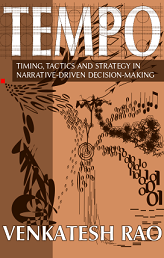Mike is a 2013 blogging resident visiting us from his home blog Omniorthogonal.
This series of posts has explored a variety of ways in which agency – the ability of something to initiate action – can be rethought, redistributed, and refactored. Agency can be assigned to things that normally don’t have it, or we can undo our everyday sense of personal agency and think of our behavior as the output of a mechanical process. My not-so-hidden agenda is to battle against the everyday notion of the self, the idea that at the core of a person is something simple and unitary. Maybe this isn’t a battle that needs to be fought – perhaps everyone, these days, is perfectly aware that they are a conflicted assemblages of drives, that personae are fictional, that autonomy is an illusion. Isn’t that conventional wisdom by now, and am I not preaching to the already converted? Hasn’t Freud been repackaged for mass consumption for decades now?
Maybe, but it seems to me that our everyday notions about agency are so baked into our culture and into the very grammar of language that the struggle against them must be ongoing. In this final post I want to explore some of the reasons why you might want to dissect your mind, and why society conspires to make that difficult. In the course of this, we’ll explore some of the moral aspects of the unity and disunity of mind. Fundamentally and perhaps obviously, morality is tied at a very basic level to the idea of a person, so that to attack the idea of personhood can seem to be be almost immoral.
I haven’t focused too much on the pragmatics of actually performing this kind of operation – such as psychological methods for refactoring yourself, or the benefits that might be obtained by doing so. A couple of interesting efforts in that line have recently come to my attention – a therapeutic technique called Internal Family Systems, and an online group trying to encourage each other to develop tulpas, “autonomous consciousness, existing within their creator’s mind…A tulpa is entirely sentient and in control of their opinions, feelings, form and movement. They are willingly created by people via a number of techniques to act as companions, muses, and advisers.” (h/t to Kevin Simler). These efforts are quite interesting, if also somewhat alarming – with this sort of stuff, if you can’t make the leap to considering the products of your imagination literally then it won’t work, but on the other hand if you do, there are very real psychological dangers. When these independent mental entities manifest on their own, we call that schizophrenia, which is no joke.



 Let’s do a quick guided tour.
Let’s do a quick guided tour.


